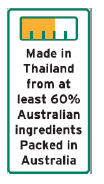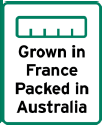In part 2 of our country of origin labelling (CoOL) series we provide a snapshot of the new mandatory labels required on packaged foods ‘grown’, ‘produced’, ‘made’ or ‘packaged’ in Australia and imported foods.
This follows part 1 which covered changes to the ‘substantial transformation test’ which are also part of the requirements under the mandatory Australian Consumer Law CoOL Information Standard (Standard) applying to food products packaged after 1 July 2018 for sale in Australia.
Food made, grown, produced and packaged outside Australia
All packaged foods imported into Australia must comply with CoOL requirements. Labels must indicate:
- the country of origin of the food; or
- if the ingredients come from more than 1 country:
- the country where the food was packaged, if applicable; and
- that the food is of multiple origins.
Priority foods must have this information in a clearly defined box on the label. For example:


Priority foods are all foods excluding:
- seasonings;
- confectionary;
- biscuits and snack food;
- bottled water;
- soft drinks and sports drinks;
- tea and coffee; and
- alcoholic beverages.
Proudly Australian
Labelling requirements also apply to priority foods ‘grown’, ‘produced’, ‘made’ or ‘packaged’ in Australia. These must be labelled in accordance with the Standard using Standard labels.
Packaged in Australia
Where a priority food is packaged in Australia, the proportion of Australian ingredients must be indicated using a bar chart in the form required under the Standard, for example:


Food ‘grown’, ‘produced’ or ‘made’ in Australia
There are 3 elements to the Standard labels for priority foods ‘grown’, ‘produced’ and ‘made’ in Australia:
- kangaroo logo;
- description of percentage of Australian ingredients; and
- the proportion of Australian ingredients illustrated in the form of a bar chart.
For example:




If the priority food ‘grown’, ‘produced’ or ‘made in’ Australia has also been exported to and from Australia, the mark must also include a description, in brackets, of the processing that occurred outside Australia (eg cleaning, shelling, packaging, re-packaging).
Priority foods containing exclusively Australian ingredients can use simplified versions of the label, such as:

Non-priority foods ‘grown’, ‘produced’ or ‘made’ in Australia must include a statement to that effect.
These changes to CoOL requirements are certainly more complex than the current regime.
What should you be doing?
Food producers and importers should seek advice early to ensure compliance by 1 July 2018. There are great resources in the CoOL Library and our team at Bespoke are here to help.
Related Posts
Country of origin labels – are you the full package?
Categories:Commercial & Corporate
Manufacturing, Distribution & Supply
Posted on: 22 April 2018

 HOME
HOME
